Introduction
On this page you will find information about the history of The Higgins family, the site, the art gallery and museum and the collections.
You can jump to:
The Higgins Bedford
The History of the Site
The Higgins Family
The Cecil Higgins Art Gallery
Bedford Museum
The Higgins Bedford
The Higgins Bedford unites on one site three previous cultural venues: Cecil Higgins Art Gallery, Bedford Museum and Bedford Gallery. The buildings themselves date back 200 years and have their own rich history of occupation and use, even before they became used for their more recent cultural past.
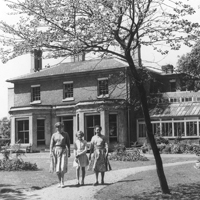
Cecil Higgins Museum circa 1955
The Higgins Family and Castle Lane
The site at Castle Lane, the Higgins family and the development of the art gallery and museum are intrinsically linked. Charles Higgins and his family moved to Bedford in the 1820s, founding the brewery at Castle Lane and building the family home next to it. The family business was very successful and they were important, influential figures within the town for over a hundred years. The brewery remained in the Higgins family until the late 1920s when Cecil Higgins, then over seventy, decided to sell it to Wells & Winch Ltd. in order to focus on his ambition to found a museum.

Higgins Brewery circa 1895
Whilst the Higgins name is not as synonymous with Bedford as Bunyan, Harpur or Howard, the family fits well within this line of philanthropists. As well as founding the brewery, Charles Higgins (c.1789-1862) was a successful Liberal politician and Mayor of Bedford. During his tenure as Mayor he was presented with a silver salver (now on display in the Mayor's Parlour) recording the "zeal, ability and humanity extended by him" during the cholera epidemic of 1849.
Following Charles Higgins' lead, the Higgins family remained devoted to Bedford life. George Higgins (1816-1883), Cecil's father, was a Justice of the Peace, a member of the Town Council and a Trustee of the Harpur Charity. Lawrence (1849-1930), Cecil's brother, was also a Justice of the Peace, and Cecil (1856-1941) was a local magistrate for many years.
Cecil ran the family business for many years but devoted his later life to collecting fine and decorative arts with the aim of founding a museum "for the benefit, interest and education of the inhabitants of, and visitors to Bedford". Cecil Higgins Art Gallery opened in 1949 in the house that had been Cecil's family home. Bedford Museum moved into the former Higgins & Sons Brewery building in 1981.
History of the Site
The art gallery and museum inhabit a complex set of historic buildings. As well as the Higgins family home and the Higgins Brewery buildings, there is the Hexagonal Gallery which is the oldest part of the site, and Bedford Gallery, a Grade II listed building.

The Hexagonal Gallery was built around 1804 upon the foundations of earthworks from Bedford Castle. Initially the building was a militia depot, and later it became St. Agnes' Elementary School. The Higgins family used the buildings as kitchen space. Since 1949 it has been used as a gallery, an office and an educational activity space. The Hexagon has now been developed as a stunning gallery to house the William Burges collection.
Bedord Gallery was built in the early 1840s. It was originally designed as a club known as the Castle Rooms, for members and supporters of the Whig Party. From 1848, the building was used by the Bunyan Meeting as a Sunday School, for Church gatherings and for teas. This lasted until the 1880s : listings show that it was then used by the Plymouth Brethren, a non-denominational Christian movement. In the early part of the 20th Century it became a billiard hall. For some time during World War Two, the BBC Music Department is believed to have used Bedford Gallery as a rehearsal room and recording studio.
History of Cecil Higgins Art Gallery
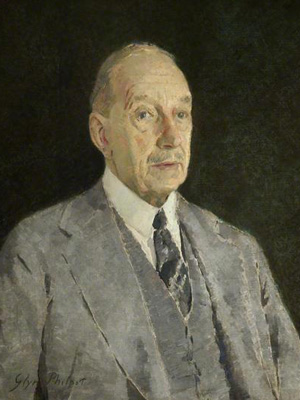
Cecil Norman Colburne Higgins, 1856-1941
Artist: Glyn Philpot R.A., 1884-1937
The Cecil Higgins Museum, as it was formerly known, opened its doors to the public on 25th July 1949, housed in the former Higgins family home. The Museum was founded by the philanthropic brewer, Cecil Higgins (1856-1941) to house his collection of ceramics, glass and objets d’art for the benefit, interest and education of the inhabitants of, and visitors to, Bedford. Cecil Higgins left a complex will to protect his collection which stipulated how the museum was to be organised. He also left a trust fund, to be used for museum purposes, but principally for acquiring works of art (which included Decorative and Applied). The Trustees of the Cecil Higgins Art Gallery still administer the trust, safeguarding the Cecil Higgins collection, enabling new acquisitions and vital conservation work.
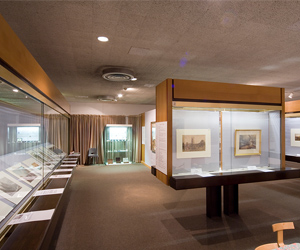
Over the years collecting policies shifted focus, moving from decorative arts to watercolours, furniture and prints. The period between 1952 and 1964, under the curatorship of Margaret Greenshields, were the most productive in terms of collecting watercolours. Over 500 were acquired in twelve years. In 1971, following the appointment of Helina Graham as curator, the collecting policy switched back to the decorative arts, with the purchase of over 200 pieces from the Handley-Read Collection including the William Burges furniture.
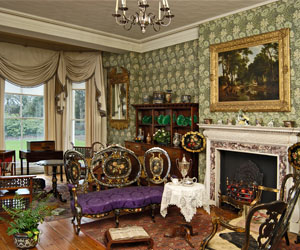
From 1988, the focus returned to collecting prints, this time concentrating on the 20th century. The print collection now numbers over 400 pieces, including works by some of the finest British artists as well as internationally renowned figures such as Picasso, Lichtenstein and Dürer. The collection charts styles as well as print processes, from Whistler’s delicate etchings to Edward Bawden’s magnificent linocuts. The last major addition to the print collection was a generous donation in 2004 from the Scottish artist Alan Davie (1920 - present) of over 70 prints, as well as five works in gouache.
In 2005, the Cecil Higgins Art Gallery merged with Bedford Museum, but retained its separate buildings and identity until it closed for redevelopment in 2007.
History of Bedford Museum
Bedford Museum was formed in the 1960s from the collections of Bedford Modern School and Bedford Borough Council. Its social history, archaeology, natural history and ethnography collections tell the stories of the people and places that have shaped Bedford, and its relationship with the wider world, from prehistory to the present day.
The Bedford Modern School museum was formed in 1884 when a solicitor called Charles Prichard donated his private collection of fossils and minerals to the school where he had formerly been a pupil. In addition he provided funds for the creation of a school museum to house the collections, with an annual grant of £10 for its upkeep. Although additions were made to the original collections, oddities from all over the world began to feature, as fathers and Old Boys travelled and took up positions in foreign lands. As a result the museum became somewhat disrespectfully known as "The Old Curiosity Shop".
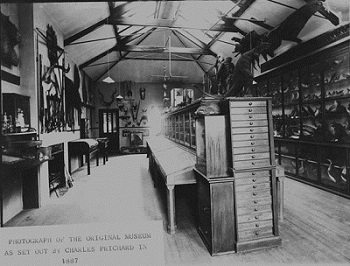
The museum developed and grew during the 1920s with the appointment of P.G. "Piggy" Langdon as Honorary Curator. For the first time the displays were opened to the public on Wednesday and Saturday afternoons, for an admission price of sixpence. With this new high-profile status the museum became recognised as one of the best school museums in England.
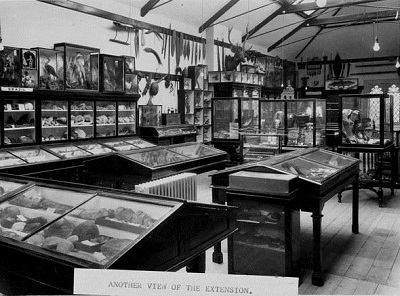
It was under the curatorship of the local historian and heraldry specialist F.W. Kuhlicke that the school entered into discussions with the Borough of Bedford to see whether the Borough could take on the public museum role. The opportunity arose to combine the school museum with the smaller collections held by the Borough of Bedford and in 1962 the newly-established town museum opened in a former garage and showroom on the Embankment, with Kuhlicke as the first Honorary Curator.
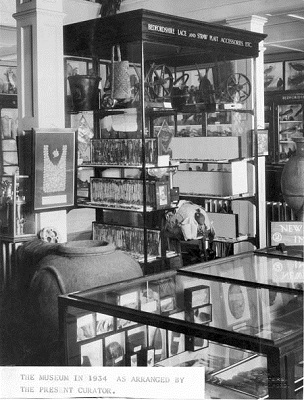
In the 1970s the former Higgins & Sons Castle Brewery buildings became available. John Turner was appointed Curator in 1974 and he led the transformation of the brewery buildings into the new town museum, which opened its doors to the public in 1981. The museum was merged with the Cecil Higgins Art Gallery in 2005, but both buildings remained essentially separate. The museum closed for redevelopment in October 2010.
The Higgins Bedford reopened on 21st June 2013.
On 25th July 2019, The Higgins Bedford celebrated the 75th anniversary of the Cecil Higgins Art Collection opening to the public.